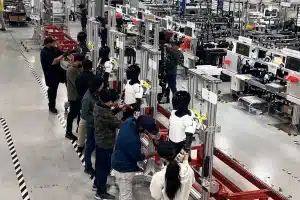- 🤖 Elon Musk predicts humanoid robots will outnumber humans by 2040.
- 🌍 Current human population estimated to rise to 9.2 billion by 2040, highlighting Musk’s claim.
- 🚀 Optimus could become a significant part of Tesla’s business strategy if the prediction materializes.
- 💰 Optimus aims to be affordable, priced under $30,000, and could set records in the industrial market.
- 🧠 Tesla’s AI project, especially with Optimus, emphasizes expanding capabilities like childcare and pet walking.
Imagine a world in 2040 where humanoid robots are as common as humans, seamlessly integrated into daily life and society. According to Tesla CEO Elon Musk, this is not science fiction but an impending reality. His bold prediction suggests that by the year 2040, humanoid robots could very well outnumber the human population on Earth. Let’s delve into how this development could be possible and what it means for the future of robotics, Tesla, and humanity itself.
A Population Estimate for Humanoids and Humans
Elon Musk has been known for his revolutionary ideas and visions, many of which have become reality. His latest prediction at the Future Investment Initiative Conference poses a radical yet intriguing prospect: by 2040, humanoid robots would surpass humans in numbers globally.
While the current human population stands at approximately 8.2 billion, experts forecast an increase to about 9.2 billion by 2040. In comparison, Musk envisions a rapid proliferation of humanoid robots, suggesting they will play a crucial role in balancing the global population dynamics.
The Potential Role of Optimus in Tesla’s Future
Tesla’s Optimus robot could be a pivotal element in Musk’s vision, marking a significant evolution in the company’s strategic approach. The development of Optimus aligns with Tesla’s overarching goal of integrating artificial intelligence into multiple facets of daily life.
Key Features of the Optimus Bot
- Affordability: Optimus aims to be accessible across various sectors, with an estimated price point below $30,000.
- Versatile Applications: It is designed to perform an array of tasks, from childcare to pet walking, offering solutions to domestic challenges and enhancing quality of life.
- Industrial Impact: This robot has the potential to set industry records by being the most popular product in industrial history, given its affordability and multifunctionality.
Analyzing the Implications on Society
1. Economic Impact
If humanoid robots become ubiquitous, there’s a potential for profound economic implications:
- Workforce Automation: As robots take over tasks, industries might see a transition in workforce dynamics, leading to shifts in employment patterns.
- Market Growth: The demand for AI technology and robotic services could skyrocket, prompting growth in new industries and services.
2. Social Integration
- Coexistence: Humans and robots will need to learn coexistence, adapting to the nuances of this new society.
- Ethical Considerations: The rise of robots brings ethical questions around AI rights, privacy, and the definition of life, which society must address.
Conclusion
The journey towards a humanoid-centric world is complicated and fascinating. As we stand on the verge of this potential transformation, it’s crucial to consider the implications of Elon Musk’s prediction. The rise of humanoid robots like Tesla’s Optimus could redefine industries, economies, and cultures on a global scale. Through strategic innovation and responsible integration, robots could indeed become vital components of our societal fabric by 2040.





